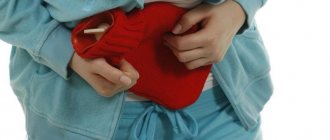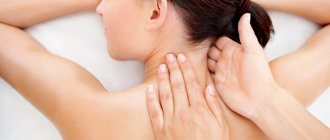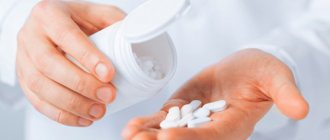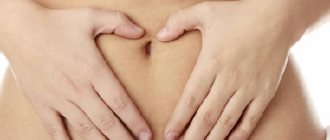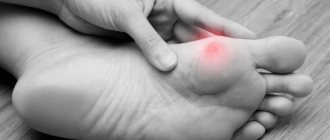Nomigren
A combined drug for relieving headache attacks of vascular origin, it helps people with migraine well. Nomigren is a relatively safe drug that contains propyphenazone, caffeine, ergotamine, meclosamine and kamilofin. "Nomigren" relieves headaches not only of a migraine nature - it is an antispasmodic and analgesic. When taking Nomigren for the first time, choose the minimum dosage, since the list of contraindications and side effects of the drug, despite its relative safety, is large.
Nomigren
Bosnalek, Bosnia and Herzegovina
acute attacks of migraine (including those accompanied by an aura);
migraine-like headaches of vascular origin. from 127
5.0 3 reviews
1319
- Like
- Write a review
Migrepam
The main active ingredient of Migrepam is zolmitriptan. This anti-migraine drug targets exactly the cause of the headache, so it helps to cope with even long-term migraines and severe episodes of headaches. In addition to headaches, Migrepam also relieves symptoms such as fear of light and sensitivity to sounds, nausea and sweating. Improvement occurs approximately an hour after taking the tablet. But not everyone can use this drug due to side effects. Therefore, be sure to consult your doctor before purchasing Migrepam.
Migrepam
Migrepam® effectively relieves headaches and other symptoms of migraine (nausea, photophobia, phonophobia).
Equally effective against migraine with aura, without aura and migraine associated with menstruation. from 166
378
- Like
- Write a review
Contraindications
Regardless of belonging to a specific clinical and pharmacological group, pain medications have a general absolute contraindication. This is individual intolerance to the active or auxiliary component.
The vast majority of them are not used during pregnancy and breastfeeding. Or they can be taken after the supervising doctor compares the benefits for the woman with the possible risks for the fetus or child.
Caution is required in patients with severe renal or hepatic diseases.
Sumamigren
This drug contains the substance sumatriptan, which has serotin-generating and anti-migraine effects. The headache is relieved quickly because vasoconstriction occurs selectively. Sumatriptan is a truly effective substance that helps quickly get rid of a migraine attack. “Sumamigren” contains only 50 mg of sumatriptan, so during an intense migraine attack you can take two tablets at once. Moreover, the headache will go away in about 15-20 minutes. But Sumamigren has serious contraindications and side effects, so it must be prescribed by a doctor.
Sumamigren
Polfa, Poland
Relief of migraine attacks with or without aura.
from 206
472
- Like
- Write a review
Amigrenin
The active ingredient of Amigrenin is also sumatriptan, but in a higher dosage than the previous medicine. Amigrenin quickly relieves migraine symptoms, not only headaches, but also other symptoms. Moreover, if you take a pill at the beginning of the aura, you can even avoid a headache. The drug contains a high dosage of sumatriptan - 100 mg - which is why Amigrenin has such a large list of contraindications.
Amigrenin
Veropharm / Lance-Farm, Russia
The active substance of the drug Amigrenin interacts with type I 5-hydroxytryptamine receptors located in the smooth muscles of the walls of blood vessels in the brain, selectively constricts blood vessels in the carotid artery system, and inhibits the activity of the trigeminal nerve.
All this helps reduce the severity of migraine pain. The clinical effect is observed after 30 minutes. from 187
724
- Like
- Write a review
Clinical and pharmacological groups
A migraine attack of mild to moderate severity can be successfully treated with traditional analgesics. But if it is severe and complicated by neurological disorders, then you cannot do without taking potent drugs. Elimination of any pain syndrome is performed by representatives of the following clinical and pharmacological groups:
- non-steroidal anti-inflammatory drugs (NSAIDs), which can simultaneously reduce temperature and stimulate the resorption of inflammatory edema;
- antispasmodics, which reduce the tone of smooth muscle muscles, indirectly improving blood circulation and lymph flow;
- analgesics that disrupt the transmission of pain impulses, exhibit antipyretic and anti-inflammatory effects, the mechanisms of which are associated with inhibition of prostaglandin biosynthesis;
- anti-migraine triptan drugs that have a selective agonistic effect on serotonin-sensitive receptors;
- medications with a combined composition, usually composed of NSAIDs, antispasmodics, sedatives or tonic active substances.
The first choice dosage forms are capsules, dragees and tablets. But with severe, throbbing, acute pain, parenteral administration of injection solutions cannot be avoided.
Sumatriptan
This drug is one of the best in the fight against persistent migraine. The active ingredient of the drug is sumatriptan succinate. "Sumatriptan" selectively constricts blood vessels without affecting cerebral blood flow. The drug not only relieves headaches, but also helps relieve other symptoms of migraine: sensitivity to light and noise, nausea. The migraine subsides just 15 minutes after taking the pill. Sumatriptan is a drug with a stable effect, so migraine attacks do not return for a long time after taking it.
Sumatriptan
Current issues in the treatment of migraine
Migraine is a chronic disease that disrupts the usual pattern of life and affects performance and family relationships.
In most cases, migraine attacks occur spontaneously and their occurrence is unpredictable. This creates a feeling of fear and apprehension in many patients and, accordingly, disrupts daily functioning. That is why WHO included migraine in the list of 19 chronic diseases that most disrupt the social adaptation of patients. At least a third of humanity suffers from migraines, with women suffering 2-3 times more often than men. A characteristic symptom of migraine headache is its onset before the age of 20 years. The essence of the disease is the periodic appearance of stereotypical attacks of throbbing pain, usually one-sided, which is accompanied by nausea, sometimes vomiting, poor tolerance of bright light, loud sounds, drowsiness, and lethargy after the attack is over. Characterized by recurrence of attacks and hereditary predisposition.
A migraine attack occurs in several phases: prodromal, aura, headache with associated symptoms, and postdromal. The prodromal period occurs before a migraine attack, ranging from a few hours to 2 days. Its typical symptoms include irritability, physical and mental hyperactivity, increased sensitivity to light, sounds, irresistible food cravings, increased bowel and bladder function, thirst, a feeling of detachment, lethargy, feeling tired, difficulty focusing vision, yawning or excessive sleepiness, slurred speech, impaired concentration, general weakness, anorexia.
The Aypa or pain phase of the attack begins after the prodromal period ends. Characterized by a gradual increase in pain and its one-sided nature. In this case, the side of pain can change even during one attack. Pain occurs in the area of the inner eye, postorbital or frontotemporal zone, is initially dull, then can become throbbing (increasing with each pulse beat). In most cases, migraine pain is very severe, lasting from 4 to 72 hours. There is historical evidence of severe intensity of migraine pain.
There are ancient legends about migraines. Even the almighty Zeus, according to one of them, had to turn to Hephaestus, the god of blacksmithing, so that he would smash his head, which was splitting from unbearable pain, with a hammer and relieve him of the monstrous migraine torment. There is also a literary example indicating a significant intensity of migraine pain. Mikhail Bulgakov in “The Master and Margarita” gave an accurate description of “a terrible, invincible disease - hemicrania, in which half the head hurts.” The procurator of Judea, Pontius Pilate, overcome by a migraine attack, saw salvation only in a portion of poison. Over the millennia, humanity has invented other ways to relieve pain, but the symptoms of the disease remain the same. Many patients in the pain phase experience a variety of symptoms such as increased sensitivity to bright light, loud sounds, and various odors.
As the migraine attack subsides, many patients experience a postdromal period, during which they experience difficulty concentrating, weakness, depression, loss of energy, poor coordination of movements, and drowsiness. The duration of this period is from several hours to two days. Migraine attacks are very diverse in severity, duration, and severity of accompanying symptoms both in different patients and in one patient. The disease is divided into two main forms: migraine without aura (MWA) and migraine with aura (MA). MBA is observed in 80% of all migraine cases. MA occurs much less frequently, in 5-10% of patients. Aura is a disorder characterized by recurrent episodes of reversible focal neurological symptoms that worsen over 5 to 20 minutes and last no more than 60 minutes. Frequent types of aura (visual, sensitive and speech) are defined as its typical forms. Visual disturbances are the most common symptom of aura, occurring in 99% of patients with MA in most attacks. Sensitive aura is observed in 30-54% of patients with MA, speech aura - in 20-32% of patients. The most typical manifestation of a visual aura is a flickering scotoma, when the image in some parts of the visual field periodically disappears, creating a sensation of flickering. A scintillating scotoma usually begins as a small blind spot in the center of the visual field that enlarges and moves. The patient may also see flashes of lightning and flickering, some see castles in the air and other interesting objects. Usually such symptoms last 20-30 minutes. Rare types of aura include olfactory, auditory, motor, aura in the form of systemic dizziness, as well as an aura with impaired neuropsychic functions. The differential diagnosis takes into account the characteristic signs of migraine. In addition to the above, there may also be: increased pain from ordinary physical activity, for example, when walking, climbing stairs; typical provoking factors: stress, weather changes, hunger, excess or insufficient sleep, alcohol intake (red wine, beer, champagne), stuffiness and menstruation; cessation of attacks in the third trimester of pregnancy. The treatment of migraine is guided by the following basic principles: 1. depending on the frequency of paroxysms - stopping attacks or preventing them; 2. taking into account the important importance of hypoxia and oxidative stress in the pathogenesis of the disease, periodic courses of antihypoxants and antioxidants. Treatment of attacks can be divided into nonspecific and specific. Nonspecific treatment involves the use of drugs that are used to treat pain of any origin and location. Specific are drugs aimed against purely migraine pain. How to relieve a painful migraine attack? Previously, people tightly bandaged their heads with a piece of linen with the names of the gods, since the disease was considered “heavenly punishment.” But the alleviating effect was most likely due to the tight bandage compressing the brain vessels. We find a similar “recipe” in Shakespeare: Desdemona eases Othello’s headache by bandaging his head with her handkerchief.
To relieve migraine attacks, drugs with a nonspecific mechanism of action are used:
- non-steroidal anti-inflammatory drugs;
- triptans are selective agonists (stimulants) of serotonin receptors;
- antiemetics (metoclopramide, domperidone, etc.).
The choice of a specific drug is the doctor’s task, taking into account previous treatment experience and patient preferences.
It is recommended to take painkillers simultaneously, or even better, 20 minutes after using antiemetics, which improve intestinal motility, accelerate gastric emptying and absorption of the analgesic. Nonsteroidal anti-inflammatory drugs (NSAIDs) traditionally occupy a significant place in the treatment and prevention of most pain syndromes. The strategy for a migraine attack is based on the choice of an effective and fast-acting NSAID. Unfortunately, preventive treatment for migraine is rarely used in everyday clinical practice. At the same time, it has been proven that success in the fight against the disease is largely determined by early and active prevention of attacks. Antidepressants may be used to treat migraines. Considering the important role of hypoxia and oxidative stress in the pathogenesis of migraine, periodic courses of antihypoxants and antioxidants are recommended according to the generally accepted scheme. Carnitines are of particular interest in this regard. Drug treatment of migraine may not be enough, therefore, in the inter-attack period, non-drug therapy is offered (mountain climate, acupuncture, transcutaneous electrical neurostimulation, hypnosis, relaxation techniques of behavioral psychotherapy, autogenic training, phototherapy, dosed hypobaric hypoxia, ozone therapy, etc.). With concomitant tension in the pericranial muscles, soft manual techniques, massage of the collar area, and reflexology are relevant.
HOW TO EAT WITH A MIGRAINE
Scientists have concluded that dietary factors may be key in the development of migraines in children and adolescents. In adults, avoiding trigger foods reduces the frequency and severity of attacks by 20-50%.
What foods are the most dangerous for migraines?
These are primarily products containing nitrates, the amino acid tyramine, the food additive monosodium glutamate, histamine, caffeine, and simple caxapa. Nitrites are a common component in sausages; it gives them a delicate pink color, and in people with migraines it causes a sharp constriction of blood vessels in the brain. Tyramine, which gives expensive cheeses a deep aroma and special taste, quickly constricts and dilates blood vessels, and also causes a deficiency of serotonin in the body, and the lack of this hormone provokes migraine attacks. Tyramine is found in large quantities in beer, pickled herring, chicken liver, yeast, and citrus fruits. Drinking red wines containing ethanol, sulfites and tyramine also leads to vasospasm and dehydration. While serotonin is often deficient in migraine sufferers, the hormone histamine is found in excess and worsens headache attacks. Therefore, you should avoid eggplants, tomatoes, avocados, cheeses, sausages, beer, red wine and sauerkraut. Monosodium glutamate (E621) causes increased activity in certain areas of the brain, which also provokes an attack. Chocolate, beloved by many, is also unsafe. It contains three migraine provoking substances - phenylethylamine, caffeine and theobromine. Prohibited foods for migraines: aged cheeses (brie, Roquefort, cheddar), cream, sour cream; chocolate, cocoa; meat and fish (smoked, dried, fatty), red caviar; offal; apples, bananas, citrus fruits, pineapples; corn, garlic, onion, sauerkraut, horseradish, radish; caffeinated drinks (coffee, tea, cola); alcohol (red wine, beer). After a diagnosis of migraine is established, the patient should determine his own list of foods that cause headaches. To do this, it is important to completely exclude foods from the “black” list from your diet for two weeks. Then enter them into the menu one at a time and observe your condition. Typically, junk food causes headaches 3-6 hours after consumption. The list of individual dietary triggers may change several times throughout life. But women should be especially attentive to their diet - their personal triggers often vary even within a month. People with migraines should not skip meals, eat dry snacks, or even go hungry. During attacks, it is necessary to limit the consumption of starchy foods (semolina, pasta, white bread), which cause the release of insulin, which provokes a migraine attack. And one more important rule: people suffering from migraines should not eat ice cream or drink cold drinks in hot weather, as the brain reacts painfully to temperature changes.
What should you eat if you have a migraine?
Scientists have discovered that foods rich in magnesium, calcium, vitamins A, B, C, and fiber for migraines are considered not just healthy, but healing.
Fish containing omega-3 fatty acids (cod, salmon, mackerel, etc.) helps prevent attacks. Of vegetable fats, unrefined flaxseed, olive and soybean oils are preferred. The spice ginger is known as a natural remedy for migraines. It has been proven that even slight dehydration provokes migraine attacks. The optimal amount of fluid consumed is at least 2 liters per day. So, foods that are good for migraines: rice (especially brown), oatmeal, buckwheat, poultry, sea fish, bran bread, wholemeal bread, feta cheese, cream cheese, sweet cottage cheese, low-fat milk, pear, cherry, cranberry, broccoli, spinach, chard, cauliflower, cucumbers, sweet potatoes, carrots, zucchini, beets, pumpkin, turnips, dried fruits, walnuts, vegetable oils (corn, olive, flaxseed, soybean). How to quickly relieve migraine pain with medications? All adult patients with migraine should be given recommendations for medication management of the attack. All patients with migraine should be treated with a stepwise approach, which involves managing three attacks at each stage before the patient moves on to the next stage. In the first stage, a nonsteroidal anti-inflammatory drug (NSAID) is used, plus, if necessary, an antiemetic. The drug of choice, especially in children, is ibuprofen. Ibuprofen is included in the international recommendations of the European Federation of Neurological Societies (EFNS) for the relief of migraine attacks (evidence level A). At the second stage, if possible and there are no contraindications, then triptans are recommended for patients who failed to help at the first stage. NSAIDs may be an effective alternative to triptans when migraine relapses. In addition to traditional tablets, which begin to act after 40 minutes, and the maximum effect occurs after 2 hours, pharmacies offer Ibuprofen CAPS
, an ultra-fast-acting drug in capsule form.
Ibuprofen CAPS, soft gelatin capsules, contain a solution of ibuprofen in polyethylene glycol. One capsule of the drug contains 200 mg of ibuprofen. One of the main advantages of Ibuprofen CAPS is the rapid onset of pain relief, which begins 15 minutes after administration. And with migraines, it is especially important to quickly relieve pain. Ibuprofen CAPS is used for headaches, toothaches, migraines, painful menstruation, neuralgia, back pain, muscle and rheumatic pain. Ibuprofen CAPS also has an antipyretic effect; a decrease in temperature during fever begins 30 minutes after administration. It also relieves cold and flu symptoms. Ibuprofen CAPS is taken in adults and children over 12 years of age, 1 or 2 capsules up to three times a day as needed, maintaining an interval of at least 4 hours between doses. If you need to take the drug for more than 10 days, or if symptoms persist or worsen, you should stop treatment and consult a doctor. Ibuprofen CAPS is completely equivalent and interchangeable with the capsules of the original drug BEFORE USING THE MEDICINE, READ THE INSTRUCTIONS Apr 21, 2021
Previous News Feed Next
